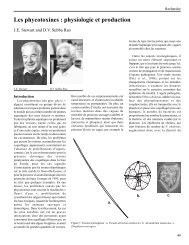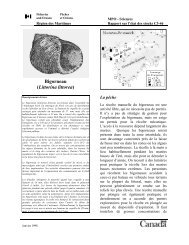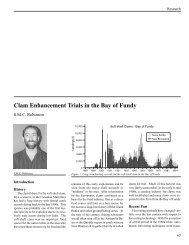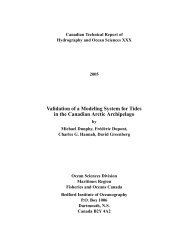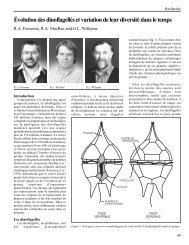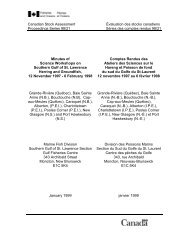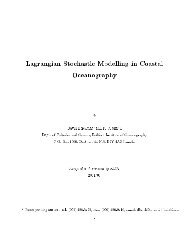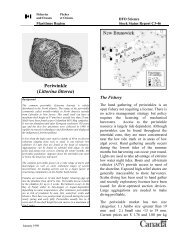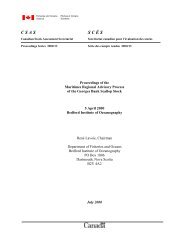ScienceActivitiesGeological Survey <strong>of</strong> Canada (Atlantic)Fossil D<strong>in</strong><strong>of</strong>lagellates Make a Difference to the Dat<strong>in</strong>g Game- Rob Fensome and Graham WilliamsA popular educational website poses the question, “How do wedeterm<strong>in</strong>e the age <strong>of</strong> a rock?” The answer accord<strong>in</strong>g to the websiteis: “By its m<strong>in</strong>erals!” It cont<strong>in</strong>ues: “Geologists first used fossils todeterm<strong>in</strong>e the relative ages <strong>of</strong> rocks. Thanks to the discovery <strong>of</strong>radioactivity and advances <strong>in</strong> technology, it is now possible to assignan absolute age to a rock.” Although this answer is not strictly <strong>in</strong>correct,it is mislead<strong>in</strong>g. The statement implies that the use <strong>of</strong> fossils isold-fashioned and no longer important for determ<strong>in</strong><strong>in</strong>g the ages <strong>of</strong>rocks and that number-crunch<strong>in</strong>g radiometric dat<strong>in</strong>g techniquesare the modern way to go. Yet <strong>in</strong> reality, radiometric-dat<strong>in</strong>g techniquesare expensive, time-consum<strong>in</strong>g, and only applicable forcerta<strong>in</strong> rock types. Fossils are still the primary tool for dat<strong>in</strong>g rocksless than half a billion years old. Moreover, fossils, especially microscopicfossils, are vital tools <strong>in</strong> understand<strong>in</strong>g the geology <strong>of</strong> oiland-natural-gas-pronesedimentary sequences such as those <strong>in</strong><strong>of</strong>fshore eastern Canada.The study <strong>of</strong> the nature, orig<strong>in</strong> and relationships <strong>of</strong> rocksequences is known as stratigraphy, and the dat<strong>in</strong>g <strong>of</strong> rocks throughtheir fossil content is called biostratigraphy. Geological periods (suchas the Jurassic) are def<strong>in</strong>ed by their biostratigraphy, not by theirabsolute age <strong>in</strong> millions <strong>of</strong> years. The best-known biostratigraphicevent is the Cretaceous-Tertiary (K-T) boundary - the ext<strong>in</strong>ction <strong>of</strong>the d<strong>in</strong>osaurs. If a rock conta<strong>in</strong>s Tyrannosaurus rex, it is Cretaceous,not Tertiary. No Tertiary rock conta<strong>in</strong>s fossils <strong>of</strong> T. rex. On the basis<strong>of</strong> radiometric dat<strong>in</strong>g, the K-T boundary is believed to be 65 millionyears old. But if new radiometric analyses were to revise the age to 60million years, this would be only a numerical re-adjustment. The K-T would not change physically s<strong>in</strong>ce it would still be def<strong>in</strong>ed by fossiloccurrences. Numerical readjustments <strong>of</strong> important stratigraphicboundaries occur more commonly than might be suspected. Forexample, the Devonian-Carboniferous boundary was changedrecently from 354 to 362 million years ago.No d<strong>in</strong>osaurs have been found <strong>in</strong> the rock cores and cutt<strong>in</strong>gs (smallrock fragments) from the oil and gas wells <strong>of</strong> <strong>of</strong>fshore eastern Canada.However, other “d<strong>in</strong>os”, fossil d<strong>in</strong><strong>of</strong>lagellates that occur <strong>in</strong> the millions,Wetzelielloid specimens – photos by Lew Stover and Dan Beju.now constitute the pr<strong>in</strong>cipal biostratigraphic tool <strong>in</strong> the region fordeterm<strong>in</strong><strong>in</strong>g the age <strong>of</strong> mar<strong>in</strong>e rocks less than 200 million years old.D<strong>in</strong><strong>of</strong>lagellates are among the most common plankton found <strong>in</strong> today’soceans. They are s<strong>in</strong>gle-celled organisms rang<strong>in</strong>g from 10-200 µm <strong>in</strong>size, and have both plant-like characteristics (many conta<strong>in</strong> chloroplasts)and animal-like features (most have an active, motile stage <strong>in</strong>their life cycle). Some d<strong>in</strong><strong>of</strong>lagellates cause red ti<strong>des</strong> and some producepotent tox<strong>in</strong>s. Fossilizable d<strong>in</strong><strong>of</strong>lagellate cysts (d<strong>in</strong>ocysts) are about thesame size as their motile counterparts, and always have a characteristicexcystment open<strong>in</strong>g, or archeopyle, through which the next generation’smotile cell can escape.Rock samples analyzed for fossilized d<strong>in</strong>ocysts must be treatedwith hydrochloric and hydr<strong>of</strong>luoric acids, plus other chemical andfractionation techniques to release the organic-walled d<strong>in</strong>ocysts.When extracted from their stony tombs, d<strong>in</strong>ocysts have been found tobe abundant. This pr<strong>of</strong>usion, plus their variable morphology and<strong>of</strong>ten rapid evolution, make d<strong>in</strong>ocysts ideal for biostratigraphy. Just asthe ext<strong>in</strong>ction <strong>of</strong> the d<strong>in</strong>osaurs represents an event that marks the end<strong>of</strong> the Cretaceous Period, so the orig<strong>in</strong>ation and ext<strong>in</strong>ction <strong>of</strong> <strong>in</strong>dividuald<strong>in</strong>ocyst species def<strong>in</strong>e particular stratigraphic events. As thedef<strong>in</strong>ition <strong>of</strong> d<strong>in</strong>ocyst species and the tim<strong>in</strong>g <strong>of</strong> their first and lastoccurrences become more ref<strong>in</strong>ed, so does our understand<strong>in</strong>g <strong>of</strong> the12 / BIO-<strong>2001</strong> IN REVIEW
SCIENCE ACTIVITIES / Geological Survey <strong>of</strong> Canada (Atlantic)Ages <strong>of</strong> the different archeopyle types <strong>in</strong> wetzelielloid d<strong>in</strong>ocysts.stratigraphy, geology, and oil and gas occurrence <strong>in</strong> the sedimentarybas<strong>in</strong>s <strong>of</strong> <strong>of</strong>fshore eastern Canada.To illustrate the develop<strong>in</strong>g ref<strong>in</strong>ement <strong>of</strong> d<strong>in</strong>ocyst biostratigraphy,we focus here on a group known as the wetzelielloids, namedafter two unrelated German pioneer biostratigraphers, Otto andWalter Wetzel. Wetzelielloids are found <strong>in</strong> 25-65 million-year-oldmar<strong>in</strong>e rocks and have proven useful <strong>in</strong> both biostratigraphy andpaleoecology. Typically, they have an ovoidal to rhomboidal shapewith 4-5 protrusions or horns: 1 anterior (apical), 1-2 posterior(antapical), and 2 lateral (a right and a left). There are also two walllayers with a space between and commonly sp<strong>in</strong>es on the outer wall;the sp<strong>in</strong>es are sometimes connected by rods (trabecula) or a th<strong>in</strong>membrane.Over the years, wetzelielloid species have been separated from oneanother on such nebulous variations as: the length, shape, andsymmetry <strong>of</strong> the horns; the nature <strong>of</strong> surface ornamentation <strong>in</strong>clud<strong>in</strong>gsp<strong>in</strong>es; and the development <strong>of</strong> walls and membranes. The fact thatthese features were so dist<strong>in</strong>ctive and variable was both a bless<strong>in</strong>g anda curse: a bless<strong>in</strong>g because the variation was easy to recognize and<strong>des</strong>cribe; but a curse because each feature seemed to develop largely<strong>in</strong>dependently <strong>of</strong> the others. No particular morphological featureprovided a consistent focus for the classification <strong>of</strong> the group orreflected a consistent stratigraphic pattern. Hence, many wetzelielloidspecies have been named and used <strong>in</strong>consistently and this hashampered the biostratigraphic usefulness <strong>of</strong> the group, <strong>des</strong>pite the use<strong>of</strong> statistical techniques such as multivariate analysis.Based on observations primarily from <strong>of</strong>fshore eastern Canada, amore effective and practical way <strong>of</strong> subdivid<strong>in</strong>g the wetzelielloids seemsto be emerg<strong>in</strong>g. This subdivision <strong>in</strong>volves giv<strong>in</strong>g priority <strong>in</strong> classificationto variations <strong>in</strong> the development <strong>of</strong> one morphological feature, thearcheopyle. The archeopyle <strong>in</strong> wetzelielloids is a more or less four-sidedopen<strong>in</strong>g on the dorsal surface <strong>of</strong> the cyst, towards the apex. As shown<strong>in</strong> the accompany<strong>in</strong>g table, different configurations <strong>of</strong> the archeopyleand its operculum are related to age, reflect<strong>in</strong>g what were apparentlygeneral evolutionary trends <strong>in</strong> the group.The authors <strong>in</strong> collaboration with Sarah Damassa <strong>of</strong> Massachusetts,USA, and Raquel Guerste<strong>in</strong> <strong>of</strong> Argent<strong>in</strong>a, are currently revis<strong>in</strong>g thetaxonomy <strong>of</strong> the wetzelielloids and re-evaluat<strong>in</strong>g the stratigraphicoccurrence <strong>of</strong> species <strong>in</strong> the group. Upon completion, the work willprovide enhanced biostratigraphic control, help<strong>in</strong>g to ref<strong>in</strong>e the ages <strong>of</strong>the strata, and hence our understand<strong>in</strong>g <strong>of</strong> the sedimentary bas<strong>in</strong>s andpetroleum systems <strong>of</strong> <strong>of</strong>fshore eastern Canada.Nares Strait: Collaborative Research to Solve a Geological Controversy- H. Ruth Jackson, Gordon N. Oakey and Sonya A. DehlerA multi-discipl<strong>in</strong>ary experiment <strong>in</strong> Nares Strait, the waterwaybetween North Greenland and Ellesmere Island, was organized underthe auspices <strong>of</strong> the Canadian-German Bilateral Agreement <strong>in</strong> Scienceand Technology and run <strong>in</strong> August and early September <strong>of</strong> <strong>2001</strong>. TheGerman Federal Institute for Geosciences and Natural Resources andthe Geological Survey <strong>of</strong> Canada (GSC) were the pr<strong>in</strong>cipal participants,with support from Danish and other Canadian agencies. Heavyice conditions <strong>in</strong> Nares Strait necessitated the use <strong>of</strong> Canada’s mostpowerful ice breaker, the CCGS Louis S. St-Laurent.The primary objective for the experiment was to collect <strong>in</strong>formationto solve a long-stand<strong>in</strong>g controversy on the orig<strong>in</strong>s <strong>of</strong> Nares Strait.This controversy has resulted from an apparent <strong>in</strong>compatibilitybetween the onshore geology surround<strong>in</strong>g Nares Strait and platetectonic models <strong>des</strong>crib<strong>in</strong>g the open<strong>in</strong>g <strong>of</strong> the North Atlantic andresult<strong>in</strong>g motions <strong>of</strong> Greenland. The major strength <strong>of</strong> this expeditionwas the ability to <strong>in</strong>tegrate targeted onshore geological field work withregional geophysical measurements to extend <strong>in</strong>terpretations <strong>of</strong>fshore.Additional scientific objectives <strong>of</strong> the program <strong>in</strong>cluded study<strong>in</strong>ggeodetic, hydrographic, oceanographic, climatological, and biologicalissues. Four students from the community <strong>of</strong> Grise Fiord and the FreeUniversity <strong>of</strong> Amsterdam participated <strong>in</strong> many <strong>of</strong> these programs.The geodetic study was a comb<strong>in</strong>ed effort coord<strong>in</strong>ated betweenGeomatics Canada (GC) and the Danish Geodetic Department. The<strong>in</strong>ternational boundary between Canada and Greenland (Denmark)lies along Nares Strait and modern position<strong>in</strong>g methods are requiredto establish its location more accurately. Also, by re-occupy<strong>in</strong>g previouslymeasured stations, modern motions <strong>of</strong> the tectonic plates canbe established. Fisheries and Oceans Canada (DFO) participated witha project to study water flow and mix<strong>in</strong>g through the Canadian ArcticIslands, and the <strong>in</strong>fluence <strong>of</strong> the Pacific Ocean as a nutrient source onBIO-<strong>2001</strong> IN REVIEW / 13




